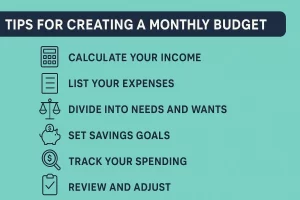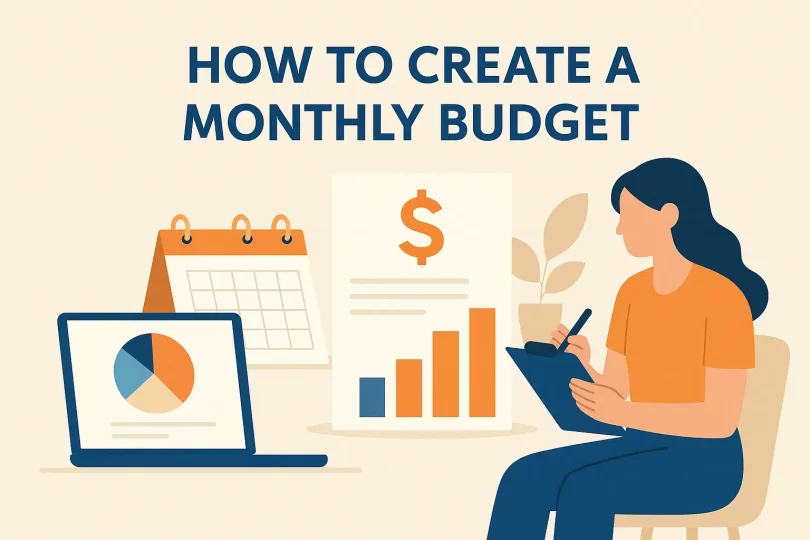Creating a monthly budget is one of the most powerful steps you can take toward financial freedom.
Yet for many people, the word “budget” feels restrictive—like a financial diet doomed to fail. But it doesn’t have to be that way.
With the right approach, budgeting becomes an empowering tool that helps you save smarter, invest wisely, and achieve your financial goals without feeling deprived.
In this guide, you’ll learn exactly how to create a monthly budget you’ll actually stick to—one that’s flexible, practical, and built around your real life.
Why Most Budgets Fail
Understanding why budgets often fail is key to building one that succeeds.
Reason |
Solution |
| Unrealistic Expectations | Create achievable targets. |
| No Flexibility | Allow room for spontaneous expenses. |
| Lack of Tracking | Use simple tools to monitor spending. |
| Neglecting Fun | Allocate money for entertainment and hobbies. |
Budgeting isn’t about restriction—it’s about smart financial planning.
How to Create a Budget That Works

1. Calculate Your Net Income
Start with the amount of money you actually take home after taxes, health insurance, and retirement contributions.
Pro Tip: If your income fluctuates (e.g., freelance work), use your average monthly income based on the last 6–12 months.
2. Track Your Expenses
Spend a full month tracking every dollar you spend.
Include essentials (rent, utilities, groceries) and non-essentials (dining out, subscriptions, shopping).
You can track expenses using:
- A simple spreadsheet (Excel or Google Sheets)
- Budgeting apps like YNAB (You Need A Budget) or Mint
3. Categorize Your Spending
Break your spending into three main categories:
- Needs (rent, groceries, transportation, healthcare)
- Wants (restaurants, entertainment, travel)
- Savings/Debt Repayment (emergency fund, retirement, paying off loans)
Following the 50/30/20 rule is a good start:
- 50% on Needs
- 30% on Wants
- 20% on Savings/Debt Repayment
4. Set Clear, Specific Financial Goals
Your budget should be aligned with what matters to you:
🎯 Short-Term Goals (0–2 years)
- Build an emergency fund
- Pay off credit card debt
🎯 Medium-Term Goals (3–5 years)
- Save for a home
- Invest for major life events
🎯 Long-Term Goals (5+ years)
- Retirement savings
- Financial independence
(Explore Now: How to Start Saving Money for Investing)
5. Choose a Budgeting Method That Fits You
There’s no “one size fits all” in budgeting.
Choose a method that matches your personality and financial habits.
Popular Budgeting Methods:
- Zero-Based Budgeting: Every dollar is assigned a job.
- 50/30/20 Rule: Balanced and simple structure.
- Envelope System: Allocate physical or digital “envelopes” for spending categories.
- Pay Yourself First: Save/invest a fixed percentage first, then spend the rest.
6. Automate What You Can
- Automate your savings, bill payments, and debt repayments whenever possible.
- Automation removes the temptation to overspend and ensures your financial priorities are funded first.
7. Review and Adjust Monthly
Life changes—and so should your budget.
At the end of each month:
- Review your spending
- Compare actual vs planned
- Adjust for upcoming months (e.g., holidays, vacations, big purchases)
Budgeting is a living document, not a rigid set of rules.
How to Stay Motivated With Your Budget
- Celebrate small wins (like paying off a small debt or reaching a savings milestone).
- Visualize your goals (vision boards, financial trackers).
- Use apps that gamify saving and spending control.
- Remind yourself that budgeting = financial empowerment, not deprivation.
Related Articles:
- 📈 Why Saving Is the First Step to Building Wealth
- 💰 Top 10 Passive Income Ideas to Grow Your Wealth
- 🏡 How to Start Investing With Just $100
A monthly budget isn’t a prison—it’s a roadmap to the life you want.
When you create a realistic, flexible, goal-driven budget, you’ll finally feel in control of your money instead of wondering where it all went.
Start simple. Stay consistent.
And watch how your small smart choices today turn into big financial wins tomorrow.








